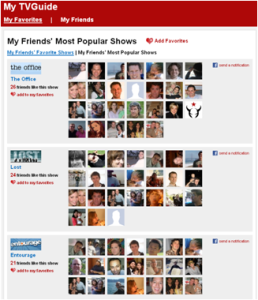 The ability to access any television program or motion picture on demand is more of a question of ‘when’ rather than ‘if’’ as internet-based delivery of digital television (known as Internet TV or IPTV) is enabling a variety of companies to already offer converged video viewing experiences to consumers.
The ability to access any television program or motion picture on demand is more of a question of ‘when’ rather than ‘if’’ as internet-based delivery of digital television (known as Internet TV or IPTV) is enabling a variety of companies to already offer converged video viewing experiences to consumers.
- Cable & Satellite Companies. While digital television services have traditionally been delivered by cable and satellite providers, these companies have also been at the forefront of providing non-linear television and movie watching capabilities through digital video recording (DVR) and video on demand (VOD) services. Now the likes of Comcast, DirecTV and Time Warner Cable are joining forces to launch TV Everywhere, a service that will enable their respective subscribers to access their television content on the web.
- Telecom Providers. AT&T and Verizon are leveraging IPTV to build the most direct competitive offering to that of cable and satellite television. These subscription services include DVR and VOD functionality while also leveraging internet connectivity to allow users to access social networking services and video content from web aggregators through their set-top boxes.
- Device Manufacturers. Television sets, Blu-ray disc players, video game consoles and digital media boxes are all incorporating Internet TV into their devices to offer consumers alternatives to traditional subscription-based linear programming. LG is producing TVs and Blu-ray players with internet capabilities to enable access to certain video websites and services. Microsoft’s Xbox system is repurposing its broadband connection used for multi-player gaming to deliver a similar video experience while also extending the social nature of the console to allow gamers to watch shows and movies with other Xbox users. Devices from Apple, Roku and Vudu offer dedicated alternatives to traditional cable and satellite boxes, providing their own content catalog to consumers in some cases or partnering with other video service providers in others.
- Internet Properties. Sites such as Amazon, Boxee, Hulu and Netflix are also leveraging the internet to provide consumers PC-based options for streaming and downloading video content as well as partnering with device manufacturers to extend their respective web offerings.
As set-top boxes and other devices become more powerful and broadband connections get faster, business models will be forced to evolve to address the control consumers have in a converged video experience. So what could slow down the adoption of on demand television by consumers? The actual user experience of finding and discovering programming.
Think about how people discover what to watch on TV today. We know what day of the week, time slot and channel a particular show is broadcast primarily through television marketing. During the airing of any show on TV the network providing the programming for that channel will advertise other shows within its portfolio along with the appropriate tune-in information (typically the show being promoted will be broadcast on the same channel on the same evening or in the same genre as the show you are watching but on another night). Word of mouth marketing from friends, coworkers, etc. fill in the rest of our content discovery needs. Now fast forward 10 years when channels and time slots in a converged video experience give way to on demand programming- how do we discover what shows and movies to watch and recommend?
Current discovery options, available primarily on video websites, are basic filters (find by name, genre, latest and most popular) associated with each site’s content catalog. Clicker, runner-up for audience favorite at TechCrunch50 recently, is trying to enhance this type of discovery by structuring the underlying data associated with video content across websites to make it easier for users to search for content as well as build their own playlists to watch.
 Filtering only provides a partial solution though. Recommendation engines that offer video suggestions to users based on particular attributes completes the discovery equation. Netflix believes in the power of recommendations enough to award $1 million to a team that was able to improve Netflix’s current movie recommendation results by 10%. While user preferences are the key to Netflix’s recommendation results, other attributes do exist. Word of mouth discovery through friends can be equally, if not more, effective. Based on the homophily principle that “birds of a feather flock together”, if your friends highlight certain shows and movies as favorites then you might be inclined to watch them as well. TV Guide, the original provider of television programming information before the internet existed, offers a web-based solution for discovery through association by leveraging Facebook Connect to allow users to access their social graph on Facebook to see what shows are their friends’ favorites.
Filtering only provides a partial solution though. Recommendation engines that offer video suggestions to users based on particular attributes completes the discovery equation. Netflix believes in the power of recommendations enough to award $1 million to a team that was able to improve Netflix’s current movie recommendation results by 10%. While user preferences are the key to Netflix’s recommendation results, other attributes do exist. Word of mouth discovery through friends can be equally, if not more, effective. Based on the homophily principle that “birds of a feather flock together”, if your friends highlight certain shows and movies as favorites then you might be inclined to watch them as well. TV Guide, the original provider of television programming information before the internet existed, offers a web-based solution for discovery through association by leveraging Facebook Connect to allow users to access their social graph on Facebook to see what shows are their friends’ favorites.
Interestingly enough I’ve yet to see anyone combine the power of push and pull (recommendations and search filters) discovery into a single solution. The company that creates an intuitive user interface that incorporates both types of discovery mechanisms to enable the programming of a television has a tremendous opportunity to own the converged video experience across multiple providers or directly with the consumer. An internet company such as Netflix, which has distribution partnerships with video service providers, a large subscriber base and a recommendation engine, is best positioned to provide this type of solution. Some might consider Hulu an option, but it has focused its efforts on being a technology and web distribution platform up to this point. From a start-up perspective, Boxee, a favorite of the early-adopter community still lacks the service distribution partnership, established media relationships and easy set-up to be considered a serious threat in the short-term.
In an on demand environment television networks and movie studios face an equally daunting task regarding discovery- how to promote their content to subscribers. Recently launched Simulmedia is attempting to address this problem for media companies by better targeting users with on-air promotions through data mining. This methodology could easily be applied to a non-linear viewing experience that could really benefit networks and studios. Services that can leverage subscriber data to target users with the appropriate programming promotion will be important as audiences are only willing to tolerate so many interruptions while watching television. Each pre-roll, mid-roll or overlay that is used for marketing television shows takes away from potential advertising dollars that could be placed there instead.
Where networks will have leverage with audiences and advertisers is in broadcasting live events. Securing rights to sporting events, award shows and the like can mitigate some of the effects of non-linear viewership. Knowing the day and time when an audience will be watching television opens up a tremendous opportunity for timing the release of shows, movies and advertising campaigns around the event.
Regardless of whether a discovery solution being implemented for consumers or provides, in a converged video experience both parties have the benefit of leveraging various user and content data sets to create a more efficient discovery process than is available to us today.
Now if I could just figure out my remote.
[tweetmeme style=”compact” only_single=”false” source=”alexcalic”]
One thought on “Television Programming Will Require Better Discovery in the Future”